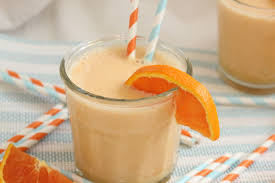The orange ones protect your eyes! Yep, that’s right, the orange colored fruits and vegetables are rich in beta-carotene which is converted to Vitamin A in our bodies to help protect our eyes. And the orange flesh-colored cantaloupes are no exception to this rule. 1 cup of cantaloupe provides 120% of our daily recommended amount of Vitamin A.
Why do we need Vitamin A? When we eat foods rich in Vitamin A, they become part of a protein known as Rhodopsin. This protein converts light into a signal that is sent to our brain to create an image, which allows us to see in dim light or at night. It also helps our eyes adjust to darkness – think dark movie theatre!
Vitamin A Deficiency: So knowing that Vitamin A helps us see in the dark, it makes perfect sense that a deficiency in this important nutrient could make it difficult for us to see at in the evening, a condition known as night blindness. This ailment makes it extremely challenging for drivers to see at night!
Vitamin A also strengthens our eyesight by nourishing our corneas and helps prevent xerophthalmia or dry eyes.
History: I like to give students a little bit of history on foods grown locally, so that they have a better idea of where their food is coming from. For example, the burpee company introduced these “netted gems” in the 1880’s and Colorado has been growing them since that time. Although cantaloupe is grown all over the state, the majority are grown in the Rocky Ford region (about an hour southeast of Pueblo). This area has been coined the “sweet melon capital of the world,” because they also grow another extremely popular summer melon – watermelon. Consider doing some research on locally grown cantaloupe in your area (if applicable) and share with your students.
Now is a great time to have students prepare recipes using these netted gems as they are in-season right now and taste so sweet and juicy – yum!
Personally, I just like to cut up cantaloupe and eat as is (I could literally eat a whole cantaloupe in one sitting – it tastes so sweet!), blend it by itself to make cantaloupe juice or even freeze it to make a cantaloupe sorbet. However if you want to introduce students to new and different ways to use cantaloupe, here are a couple of recipes to try.
Cantaloupe Creamsicle Smoothie

Image courtesy of: http://www.kitchenfrau.com/creamsicle-smoothie/
Servings: 3
Ingredients:
- ½ medium cantaloupe
- ¼ cup plant-powered milk (I prefer soymilk because it makes it creamier, but you can also use almond milk.)
- ¼ cup fresh pressed orange juice – no sugar added and not from concentrate.
Directions:
- Thoroughly wash and dry (if possible use a fruit and vegetable wash) the cantaloupe rind before cutting it. This may help reduce your risk of food poisoning.
- Then cut and dice your cantaloupe. This article does a good job of explaining the necessary steps to cut a cantaloupe http://www.onceuponachef.com/how-to/how-to-cut-a-melon.html.
- Add diced cantaloupe to a blender and then add plant milk, and orange juice. Blend until desired smoothness. Some like it smooth and even juice-like, while others like it a little thicker.
Nutrition Facts: Here is the nutrition label for this recipe. As you can see, per serving this recipe provides 104% of your daily recommended amount for Vitamin A and as an added bonus, it provides 85% of your daily recommended amount for Vitamin C. Plus it is a good source of potassium and contains iron.
| Nutrition Facts |
| Servings: 3 |
| Per Serving |
% Daily Value* |
| Calories 52 |
|
| Total Fat 0.6g |
1% |
| Saturated Fat 0.1g |
1% |
| Trans Fat 0g |
|
| Cholesterol 0mg |
0% |
| Sodium 25mg |
1% |
| Potassium 311mg |
7% |
| Total Carb 10.9g |
4% |
| Dietary Fiber 1g |
4% |
| Sugars 9.8g |
|
| Protein 1.6g |
|
| Vitamin A 104% · Vitamin C 85% |
| Calcium 1% · Iron 3% |
| *Based on a 2,000 calorie diet |
Recipe analyzed by  |
If you have a little bit more time, here is another fun, simple recipe to make with students.
Cantaloupe Sorbet

Image courtesy of: http://thekitchenmccabe.com/2014/06/23/cantaloupe-melon-sorbet/
Servings: 4-5
Ingredients:
- ½ medium cantaloupe (approximately 2 cups)
- ½ tablespoon lemon juice
- 2 tablespoons honey
- 2 tablespoons water
Directions:
- Thoroughly wash and dry (if possible use a fruit and vegetable wash) the cantaloupe rind before cutting it. This may help reduce your risk of food poisoning.
- Then cut and dice your cantaloupe. This article does a good job of explaining the necessary steps to cut a cantaloupe http://www.onceuponachef.com/how-to/how-to-cut-a-melon.html.
- Place diced cantaloupe onto a parchment paper lined cookie sheet and place in freezer. Freeze for a few hours to overnight.
- Place frozen cantaloupe, lemon juice, honey and water into a food processor. Blend until it has a sorbet or ice-cream-like texture.
- Serve immediately.
I use this recipe as a starting point and then add other ingredients to make it even more spectacular. Try replacing the water with 6 ounces of blueberries or check out an additional recipe at the Colorado Fruit and Vegetable Growers Association Facebook Page – https://www.facebook.com/CFVGA/





